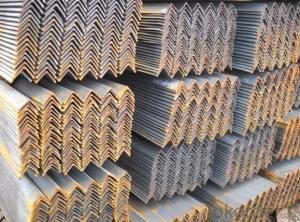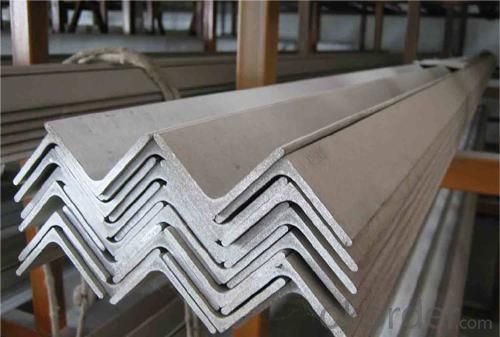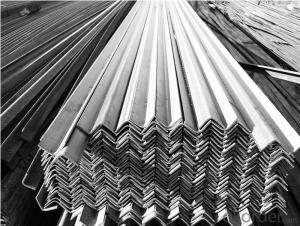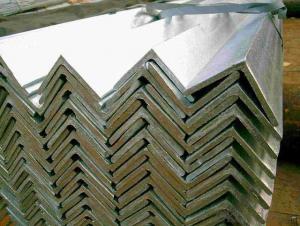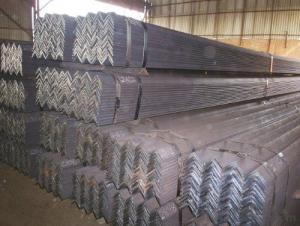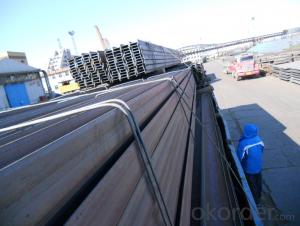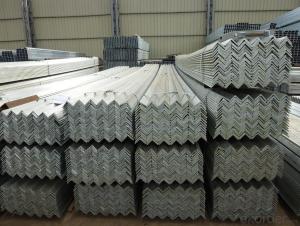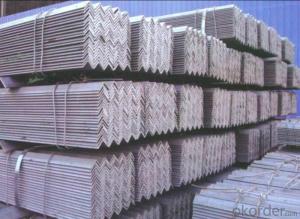A38*38*6 hot sell Equal Angle for construction
- Loading Port:
- Tianjin
- Payment Terms:
- TT OR LC
- Min Order Qty:
- 25 m.t.
- Supply Capability:
- 10000 m.t./month
OKorder Service Pledge
OKorder Financial Service
You Might Also Like
Product Description:
Specifications of Angle Steel
1. Invoicing on theoretical weight or actual weight as customer request
2. Length: 6m, 9m, 12m as following table
3. Sizes
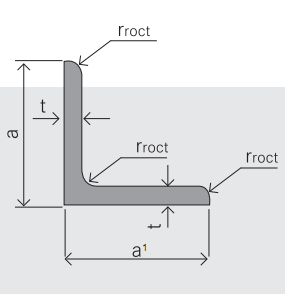
Sizes: 25mm-250mm | ||
a*t | ||
25*2.5-4.0 | 70*6.0-9.0 | 130*9.0-15 |
30*2.5-6.6 | 75*6.0-9.0 | 140*10-14 |
36*3.0-5.0 | 80*5.0-10 | 150*10-20 |
38*2.3-6.0 | 90*7.0-10 | 160*10-16 |
40*3.0-5.0 | 100*6.0-12 | 175*12-15 |
45*4.0-6.0 | 110*8.0-10 | 180*12-18 |
50*4.0-6.0 | 120*6.0-15 | 200*14-25 |
60*4.0-8.0 | 125*8.0-14 | 250*25 |
5. Payment terms:
1).100% irrevocable L/C at sight.
2).30% T/T prepaid and the balance against the copy of B/L.
3).30% T/T prepaid and the balance against L/C
6.Material details:
Alloy No | Grade | Element (%) | |||||
C | Mn | S | P | Si | |||
|
|
|
|
|
|
| |
Q235 | B | 0.12—0.20 | 0.3—0.7 | ≤0.045 | ≤0.045 | ≤0.3 | |
|
|
|
|
|
|
| |
Alloy No | Grade | Yielding strength point( Mpa) | |||||
Thickness (mm) | |||||||
≤16 | >16--40 | >40--60 | >60--100 | ||||
≥ | |||||||
|
|
|
|
|
| ||
Q235 | B | 235 | 225 | 215 | 205 | ||
Alloy No | Grade | Tensile strength (Mpa) | Elongation after fracture (%) | ||||
Thickness (mm) | |||||||
| ≤16 | >16--40 | >40--60 | >60--100 | |||
≥ | |||||||
|
|
|
|
|
|
| |
Q235 | B | 375--500 | 26 | 25 | 24 | 23 | |
Usage & Applications of Angle Steel
According to the needs of different structures, Angle can compose to different force support component, and also can be the connections between components. It is widely used in various building structures and engineering structures such as roof beams, bridges, transmission towers, hoisting machinery and transport machinery, ships, industrial furnaces, reaction tower, container frame and warehouse etc.
Packaging & Delivery of Angle Steel
1. Packing: it is nude packed in bundles by steel wire rod
2. Bundle weight: not more than 3.5MT for bulk vessel; less than 3 MT for container load
3. Marks:
Color marking: There will be color marking on both end of the bundle for the cargo delivered by bulk vessel. That makes it easily to distinguish at the destination port.
Tag mark: there will be tag mark tied up on the bundles. The information usually including supplier logo and name, product name, made in China, shipping marks and other information request by the customer.
If loading by container the marking is not needed, but we will prepare it as customer request.
Production flow of Angle Steel
Material prepare (billet) —heat up—rough rolling—precision rolling—cooling—packing—storage and transportation
Angle, commonly known as Angle on both sides of the cross section is vertical at right angles to each other shape of strip steel. Angle has the points of equal Angle and unequal Angle, two vertical edge length is the same as equal Angle, a long a short for unequal Angle. Its specification in a thick edge width x width x while millimeters said. Angle is the main purpose of: it is mainly used for making frame structure, such as high voltage power transmission tower, steel structure framework on either side of the bridge girder, tower crane on the construction site of pillar and arm, workshop of the column and beam, a small pot shape such as for the side of the road in the place where hung under the shelf, in the window of the solar energy air conditioning rack, etc.
A, Marine Angle steel
Marine Angle of main product description: due to the ship's working environment is bad, so, Marine Angle steel material performance has good toughness, high strength, good corrosion resistance, weldability, and surface properties, etc. The chemical composition of material with normal Angle is not the same. Its main purpose is: it is mainly used for hull internals, etc. 3 N7
Second, the ball flat steel
The ball flat steel is a kind of is mainly used in shipbuilding and to build a bridge in the field of the profiles, including Marine ball flat steel in shipbuilding with auxiliary material. Main product features are:
1, exterior light round, no lines without ribs, and other shaped groove or rib steel surface. This will cause the cohesive force of small flat steel and concrete, and the other the cohesive force of steel bar and reinforced concrete.
2, flat steel smelting in converter, main USES the hot metal as raw material, the harmful elements in molten iron is less, produce the flat steel quality assured.
3, small continuous casting billet length rate is high, can guarantee the flat steel scale rate, meet the needs of users.
Three, L steel
L the Angle steel is also called the unequal different thickness, is adapt to the needs of large ship building and production of new material. L steel except for large ships, can also be used in ocean engineering structure and construction engineering structure of high demand. Its main advantages are:
1, in section height and abdominal advise on the same case, L shape section coefficient and the stiffness is larger than the ball flat steel
2, in the same section coefficient, L was a little thinner than the ball flat steel, steel panel thickness is helpful to improve the quality of the weld.
3, under the condition of same cross section coefficient, increase the storage vessel, improve the economic benefit.
Angle, commonly known as Angle on both sides of the cross section is vertical at right angles to each other shape of strip steel. Angle has the points of equal Angle and unequal Angle, two vertical edge length is the same as equal Angle, a long a short for unequal Angle. Its specification in a thick edge width x width x while millimeters said. Angle is the main purpose of: it is mainly used for making frame structure, such as high voltage power transmission tower, steel structure framework on either side of the bridge girder, tower crane on the construction site of pillar and arm, workshop of the column and beam, a small pot shape such as for the side of the road in the place where hung under the shelf, in the window of the solar energy air conditioning rack, etc.
A, Marine Angle steel
Marine Angle of main product description: due to the ship's working environment is bad, so, Marine Angle steel material performance has good toughness, high strength, good corrosion resistance, weldability, and surface properties, etc. The chemical composition of material with normal Angle is not the same. Its main purpose is: it is mainly used for hull internals, etc. 3 N7
Second, the ball flat steel
The ball flat steel is a kind of is mainly used in shipbuilding and to build a bridge in the field of the profiles, including Marine ball flat steel in shipbuilding with auxiliary material. Main product features are:
1, exterior light round, no lines without ribs, and other shaped groove or rib steel surface. This will cause the cohesive force of small flat steel and concrete, and the other the cohesive force of steel bar and reinforced concrete.
2, flat steel smelting in converter, main USES the hot metal as raw material, the harmful elements in molten iron is less, produce the flat steel quality assured.
3, small continuous casting billet length rate is high, can guarantee the flat steel scale rate, meet the needs of users.
Three, L steel
L the Angle steel is also called the unequal different thickness, is adapt to the needs of large ship building and production of new material. L steel except for large ships, can also be used in ocean engineering structure and construction engineering structure of high demand. Its main advantages are:
1, in section height and abdominal advise on the same case, L shape section coefficient and the stiffness is larger than the ball flat steel
2, in the same section coefficient, L was a little thinner than the ball flat steel, steel panel thickness is helpful to improve the quality of the weld.
3, under the condition of same cross section coefficient, increase the storage vessel, improve the economic benefit.
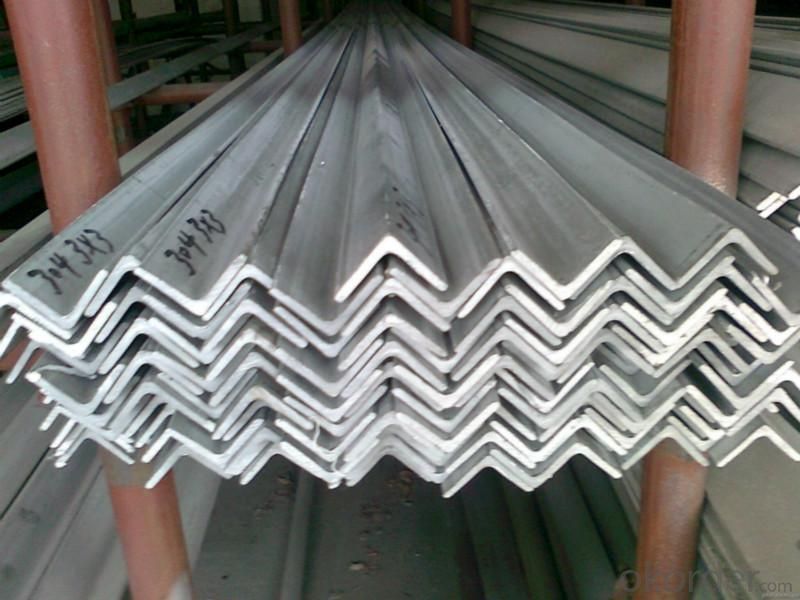
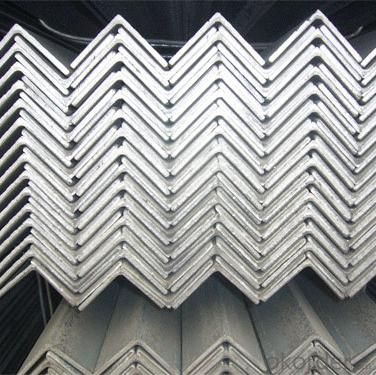
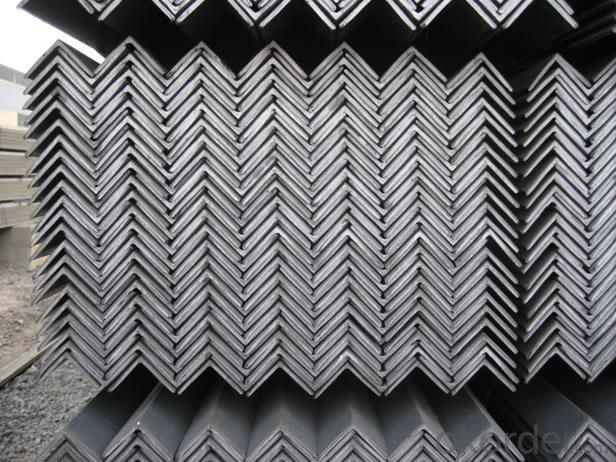
- Q: Are steel angles suitable for balcony railings?
- Yes, steel angles are suitable for balcony railings. Steel angles are strong, durable, and resistant to corrosion, making them an ideal choice for outdoor applications like balcony railings. They provide excellent structural support and can withstand heavy loads, ensuring the safety of individuals leaning on or using the balcony railing. Additionally, steel angles can be easily fabricated and customized to fit the specific design requirements of the balcony, making them a versatile option. Overall, steel angles are a reliable and long-lasting choice for balcony railings.
- Q: What are the guidelines for designing connections using steel angles?
- The guidelines for designing connections using steel angles typically involve determining the appropriate angle size, thickness, and length based on the loads and forces that will be applied to the connection. Additionally, considerations such as the type of welds or bolts to be used, the spacing and arrangement of the angles, and any applicable design codes or standards must be taken into account. It is important to ensure that the connection is structurally sound and provides adequate strength and stability for the intended application.
- Q: Are steel angles suitable for earthquake-resistant construction?
- Steel angles can indeed be suitable for earthquake-resistant construction. Steel is a material known for its high strength and ductility, making it ideal for withstanding seismic forces. Steel angles, in particular, are commonly used in seismic design and construction due to their ability to provide structural stability. Steel angles are often used as bracing elements in buildings to resist lateral forces caused by earthquakes. They can be installed diagonally between structural members to create a rigid frame that can effectively absorb and dissipate seismic energy. These angles help distribute the forces generated during an earthquake and prevent the collapse of the structure. Furthermore, steel angles can be designed and fabricated to meet specific seismic design criteria. The design can take into account factors such as the building's location, expected seismic activity, and the desired level of earthquake resistance. By using advanced computer-aided design and analysis tools, engineers can optimize the placement and size of steel angles to enhance the overall seismic performance of the structure. In addition to their strength and ductility, steel angles offer other advantages for earthquake-resistant construction. They are lightweight, which reduces the overall weight of the structure and allows for more efficient seismic design. Steel is also a recyclable material, making it a sustainable choice for construction projects. However, it is important to note that the suitability of steel angles for earthquake-resistant construction depends on several factors, including the specific design, construction techniques, and adherence to building codes and regulations. Professional engineering expertise and thorough analysis are necessary to ensure the appropriate use of steel angles in seismic design. In summary, steel angles are suitable for earthquake-resistant construction due to their strength, ductility, and ability to provide structural stability. When properly designed and installed, they can effectively resist seismic forces and contribute to the overall safety and resilience of the structure.
- Q: Are steel angles suitable for mezzanine floor construction?
- Yes, steel angles are suitable for mezzanine floor construction. Steel angles provide structural support and stability, making them a popular choice for building mezzanine floors. They are strong, durable, and can withstand heavy loads, making them an ideal choice for creating additional floor space in industrial or commercial settings.
- Q: I would like to ask you, angle iron, what does it usually use ah?
- Mainly used for making steel frame structure, such as high-voltage transmission tower, steel structure bridge on both sides of the frame, the construction site of the tower crane arm, workshop columns and columns and beams, small holiday places such as roadside stands, the window in the other pot under the air conditioning solar rack etc..
- Q: Can steel angles be used for manufacturing machinery?
- Yes, steel angles can be used for manufacturing machinery. Steel angles provide structural support and can be used as framing members, braces, or brackets in machinery construction. They offer high strength, durability, and versatility, making them suitable for various industrial applications.
- Q: Are steel angles resistant to UV radiation?
- Steel angles do not naturally possess resistance to UV radiation. However, the degree of resistance can vary based on the type of steel utilized and the application of a protective coating on the surface. When left unprotected, steel angles like hot-rolled or cold-formed steel can undergo deterioration and corrosion when exposed to UV radiation for extended periods. The ultraviolet rays have the ability to induce oxidation in the steel, resulting in the formation of rust and weakening the structure. To counteract the impact of UV radiation, protective finishes such as galvanized zinc, paint, or powder coating can be applied to steel angles. These coatings act as a barrier between the steel and the surroundings, offering protection against UV radiation and preventing oxidation and corrosion. It is important to acknowledge that despite the presence of protective coatings, prolonged exposure to intense UV radiation can still cause some deterioration over time. Therefore, regular inspection and maintenance are crucial in ensuring the durability and structural integrity of steel angles utilized in outdoor or UV-exposed applications.
- Q: What is the maximum load capacity for a steel angle bracket?
- The maximum load capacity for a steel angle bracket depends on various factors such as the dimensions of the bracket, the thickness and quality of the steel used, the method of installation, and the intended use of the bracket. Generally, steel angle brackets are designed to support heavy loads and can handle significant weight. However, it is crucial to consult the manufacturer's specifications or engineering guidelines for the specific bracket in question to determine its maximum load capacity. These specifications will provide accurate information on the maximum weight or load that the steel angle bracket can safely support without compromising its structural integrity.
- Q: What are the alternatives to steel angles in construction?
- Some alternatives to steel angles in construction include aluminum angles, fiberglass angles, and plastic angles. These materials offer different properties such as lightweight, corrosion resistance, and flexibility, making them suitable for various construction applications.
- Q: Can steel angles be used in construction?
- Yes, steel angles can be used in construction. Steel angles are commonly used structural elements in construction projects due to their versatility, strength, and cost-effectiveness. They are typically used for supporting and reinforcing various structural components, such as beams, columns, and walls. Steel angles are available in various sizes and thicknesses, making them suitable for a wide range of applications in construction. They can be easily welded, bolted, or fastened together, allowing for easy installation and customization on-site. One of the key advantages of using steel angles in construction is their high strength-to-weight ratio. This means that steel angles provide excellent load-bearing capacity while being relatively lightweight, making them ideal for structures that require strength without excessive weight. Additionally, steel angles offer excellent durability and resistance to environmental factors such as corrosion, fire, and pests. This ensures that structures built with steel angles have a longer lifespan and require less maintenance over time. Overall, steel angles are a versatile and reliable choice for construction projects, whether it be for residential, commercial, or industrial applications. Their strength, durability, and ease of installation make them a preferred choice among architects, engineers, and contractors.
Send your message to us
A38*38*6 hot sell Equal Angle for construction
- Loading Port:
- Tianjin
- Payment Terms:
- TT OR LC
- Min Order Qty:
- 25 m.t.
- Supply Capability:
- 10000 m.t./month
OKorder Service Pledge
OKorder Financial Service
Similar products
Hot products
Hot Searches
Related keywords
